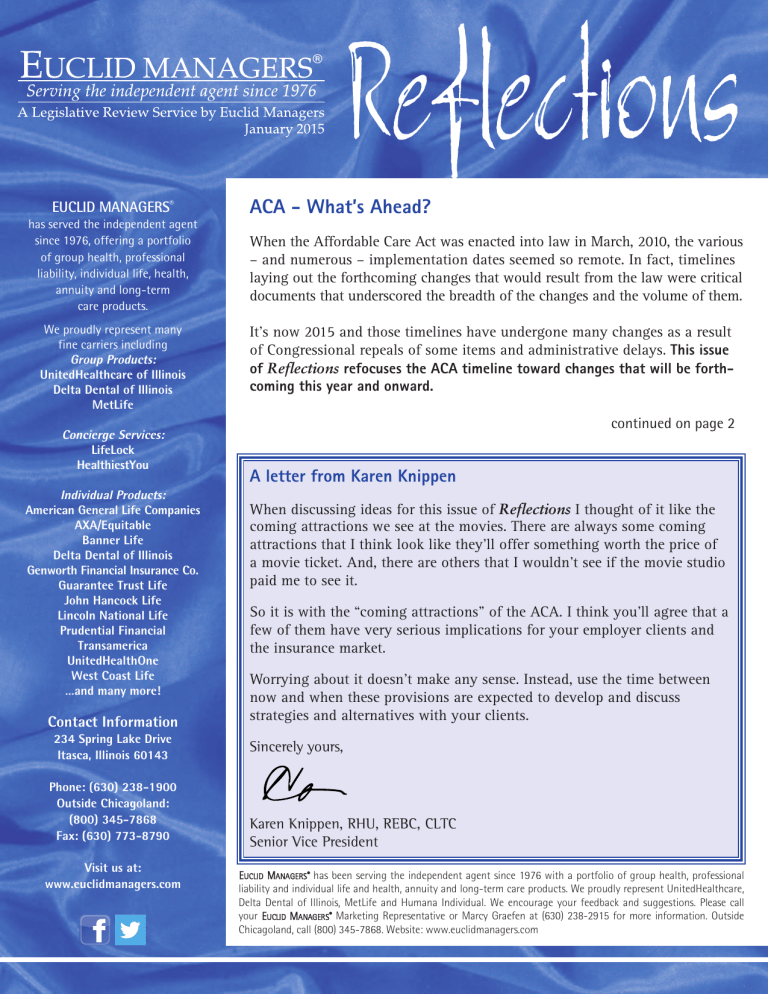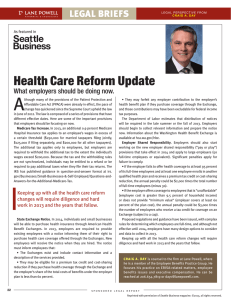ACA - What’s Ahead?

EUCLID MANAGERS ® has served the independent agent since 1976, offering a portfolio of group health, professional liability, individual life, health, annuity and long-term care products.
We proudly represent many fine carriers including
Group Products:
UnitedHealthcare of Illinois
Delta Dental of Illinois
MetLife
Concierge Services:
LifeLock
HealthiestYou
Individual Products:
American General Life Companies
AXA/Equitable
Banner Life
Delta Dental of Illinois
Genworth Financial Insurance Co.
Guarantee Trust Life
John Hancock Life
Lincoln National Life
Prudential Financial
Transamerica
UnitedHealthOne
West Coast Life
…and many more!
Contact Information
234 Spring Lake Drive
Itasca, Illinois 60143
Phone: (630) 238-1900
Outside Chicagoland:
(800) 345-7868
Fax: (630) 773-8790
Visit us at: www.euclidmanagers.com
ACA - What’s Ahead?
When the Affordable Care Act was enacted into law in March, 2010, the various
– and numerous – implementation dates seemed so remote. In fact, timelines laying out the forthcoming changes that would result from the law were critical documents that underscored the breadth of the changes and the volume of them.
It’s now 2015 and those timelines have undergone many changes as a result of Congressional repeals of some items and administrative delays.
This issue of Reflections refocuses the ACA timeline toward changes that will be forthcoming this year and onward.
A letter from Karen Knippen
continued on page 2
When discussing ideas for this issue of Reflections I thought of it like the coming attractions we see at the movies. There are always some coming attractions that I think look like they’ll offer something worth the price of a movie ticket. And, there are others that I wouldn’t see if the movie studio paid me to see it.
So it is with the “coming attractions” of the ACA. I think you’ll agree that a few of them have very serious implications for your employer clients and the insurance market.
Worrying about it doesn’t make any sense. Instead, use the time between now and when these provisions are expected to develop and discuss strategies and alternatives with your clients.
Sincerely yours,
Karen Knippen, RHU, REBC, CLTC
Senior Vice President
E UCLID M ANAGERS
® has been serving the independent agent since 1976 with a portfolio of group health, professional liability and individual life and health, annuity and long-term care products. We proudly represent UnitedHealthcare,
Delta Dental of Illinois, MetLife and Humana Individual. We encourage your feedback and suggestions. Please call your E UCLID M ANAGERS
® Marketing Representative or Marcy Graefen at (630) 238-2915 for more information. Outside
Chicagoland, call (800) 345-7868. Website: www.euclidmanagers.com
Holdovers
There are items that were to be implemented that remain outstanding, waiting in the wings as it were. One of these provisions is the application of nondiscrimination rules to insured group health plans.
The Treasury
Department signaled that this provision would not be enforced until rules could be proposed with adequate time for employers to come into compliance. Since rules have still not been published, it is unlikely that insured plans will have to be in compliance before plan years beginning in 2016, at the earliest.
Another provision that has yet to be implemented is the requirement that plans with 200 or more employees have an auto-enrollment provision.
While auto-enrollment for retirement plans has become more popular, regulators understand that auto-enrollment into a health plan is more complicated.
2015
After several delays, many large employers will be subject to the “pay or play” provisions as of the first day of 2015 or at the time a plan renews in 2015.
Some large employers with 50 to 99 full-time equivalent employees may have additional transition relief that delays compliance with the “pay or play” provisions into 2016.
The IRS Frequently Asked Questions publication on the final Employer Responsibility Rules outlines the requirements for mid-size employer transition relief:
34. Is additional transition relief available for employers with at least 50 but fewer than 100 full-time employees (including full-time equivalents)?
Yes. For employers with fewer than 100 full-time employees (including full-time equivalents) in 2014, that meet the conditions described below, no
Employer Shared Responsibility payment under section 4980H(a) or (b) will apply for any calendar month during 2015. For employers with noncalendar-year health plans, this applies to any calendar month during the 2015 plan year, including months during the 2015 plan year that fall in 2016.
In order to be eligible for the relief, an employer must certify that it meets the following conditions:
-2- Reflections
(1) Limited Workforce Size.
The employer must employ on average at least 50 full-time employees
(including full-time equivalents) but fewer than 100 full-time employees (including full-time equivalents) on business days during 2014. (Employers with fewer than 50 full-time employees (including full-time equivalents) on business days during the previous year are not subject to the Employer Shared
Responsibility provisions.) The number of full-time employees (including full-time equivalents) is determined in accordance with the otherwise applicable rules in the final regulations for determining status as an applicable large employer.
(2) Maintenance of Workforce and Aggregate Hours of Service.
During the period beginning on Feb. 9,
2014 and ending on Dec. 31, 2014, the employer may not reduce the size of its workforce or the overall hours of service of its employees in order to qualify for the transition relief. However, an employer that reduces workforce size or overall hours of service for bona fide business reasons is still eligible for the relief.
(3) Maintenance of Previously Offered Health
Coverage.
During the period beginning on Feb. 9,
2014 and ending on Dec. 31, 2015 (or, for employers with non-calendar-year plans, ending on the last day of the 2015 plan year) the employer does not eliminate or materially reduce the health coverage, if any, it offered as of Feb. 9, 2014. An employer will not be treated as eliminating or materially reducing health coverage if (i) it continues to offer each employee who is eligible for coverage an employer contribution toward the cost of employee-only coverage that either
(A) is at least 95 percent of the dollar amount of the contribution toward such coverage that the employer was offering on Feb. 9, 2014, or (B) is at least the same percentage of the cost of coverage that the employer was offering to contribute toward coverage on Feb. 9, 2014; (ii) in the event of a change in benefits under the employee-only coverage offered, that coverage provides minimum value after the change; and (iii) it does not alter the terms of its group health plans to narrow or reduce the class or classes of employees (or the employees’ dependents) to whom coverage under those plans was offered on
Feb. 9, 2014.
For employers that had not offered dependent coverage during the 2013 or 2014 plan years, there is transition relief and no penalty solely on account of a failure to offer coverage to dependents if the large employer has taken steps to extend coverage to dependents in 2015.
The IRS FAQ document notes:
This extended transition relief applies to employers for the 2015 plan year for plans under which (1) dependent coverage is not offered, (2) dependent coverage that does not constitute minimum essential coverage is offered, or (3) dependent coverage is offered for some, but not all, dependents.
Another provision that is slated for action in 2015 is reauthorization of the federal Children’s Health Insurance
Program, CHIP. If this program isn’t reauthorized or if there are significant changes to it, employers may experience a ripple effect in enrollment in employer based plans.
2016
One of the provisions of the ACA was a redefinition of the small employer group size as including employers up to 100 employees in size.
States had – and almost without exception chose - the option in 2014 to delay the implementation of these ACA insurance market reforms by retaining the small group definition at 50 employees.
Absent further change, employers with up to 100 employees will be redefined as small groups in 2016. As a result, these employer plans will be subject to the modified community rating standards which are now limited to smaller groups.
There is no similar readjustment to the “pay or play” provisions that would adjust the penalty thresholds so that mid-size employers would no longer be exposed to the penalties.
Employers will also have to begin filing reports based on
2015 data to fulfill the reporting requirements of the
ACA.
2017
States obtain the option to allow large employers to purchase group coverage through the exchange.
If a state elects to do this, employer plans – irrespective of employer size – will be subject to the modified community rating and other provisions that had been required of small group plans. The market reforms would apply to large groups whether they purchased coverage through the exchange or outside the exchange.
2018
One of the provisions that has caught the attention of employers is due in 2018, the “Cadillac tax.” This tax is a
40% excise tax on high-cost plans. The tax is paid by the insurer in a fully insured group or by the self-funded employer.
The amount of the high-cost plan is set for plans with values that exceed $10,200 for individual coverage and
$27,500 for family coverage. The tax thresholds are indexed for inflation, but at the rate of general inflation rather than medical inflation. There will be higher thresholds for retirees over age 55 and for employees in certain high-risk professions. Rules implementing this tax have not yet been proposed.
With ACA – Expect Change
According to the Galen Institute, there have already been more than 42 significant changes to the ACA.
Currently, there are several court cases regarding various provisions of the ACA with the Supreme Court expected to weigh in on the state exchange versus federal exchange subsidy issue later in the year.
At the same time, Republicans in Congress – and some
Democrats – have been calling for changes to be made.
There are some politicians who still believe that a full repeal of the Act is possible, despite how difficult it would be to roll back all of the law’s provisions after several years.
Brokers and employers should consider the upcoming provisions outlined in this issue of Reflections as a guide to developing benefits strategy for the near future.
Any unexpected changes that occur will then, hopefully, be pleasant ones that employers will be able to readily adapt.
Reflections -3-
Presorted
First-Class Mail
U.S. Postage
PAID
Addison, IL 60101
Permit No. 210
Inside:
ACA - What’s Ahead?
n fe rae e.
y G urc arc
so to r M it e o ed tiv
cr nta ith se
w re te ep uo
R o q ng n t eti io ark iss r M erm ou
P t y
0. © tac
25 on
44 on
-2
, c
) 4 ati
77 rm
(8 fo ax
in re
8, F mo
86 -7 or
45
. F
) 3
43
00
01 6
: (8 nd
, IL ola sca ag
Ita e., hic riv e C
D id ke uts
La
0. O ng pri
79 -8
S 34
73
, 2
®
) 7 30 ers
(6 ag
to an est
M qu id re ucl ur y E yo d b ax he r f lis
5 o ub
91
p
-2
is
38 ew
) 2 evi
30 (6 e R at tiv la gis Le
.euclidmanagers.com.
Visit us online www
ough Euclid Managers Concierge Services.
HealthiestY ou and Lifelock available thr
MetLife and Humana Individual.
UnitedHealthcare of Illinois, Delta Dental of Illinois, epresenting , proudly r
®





